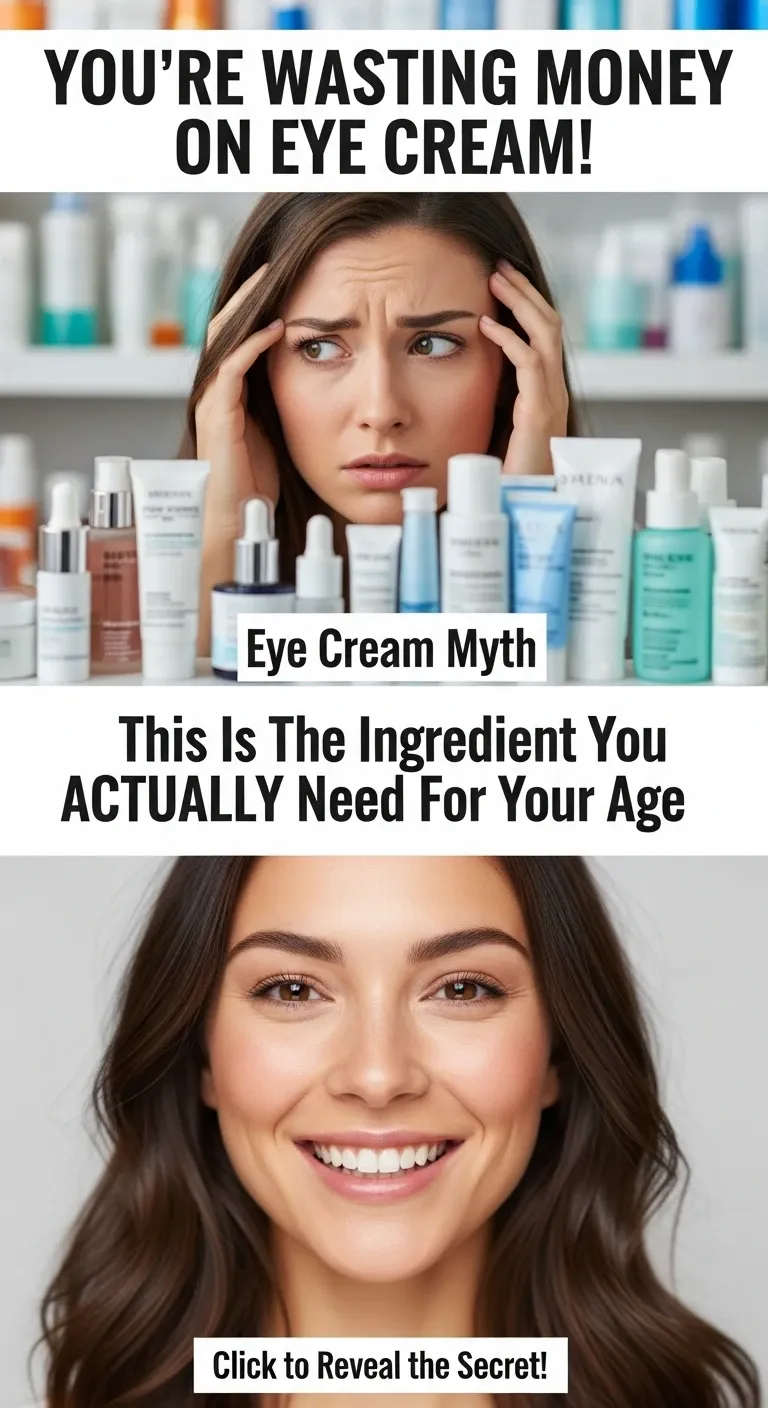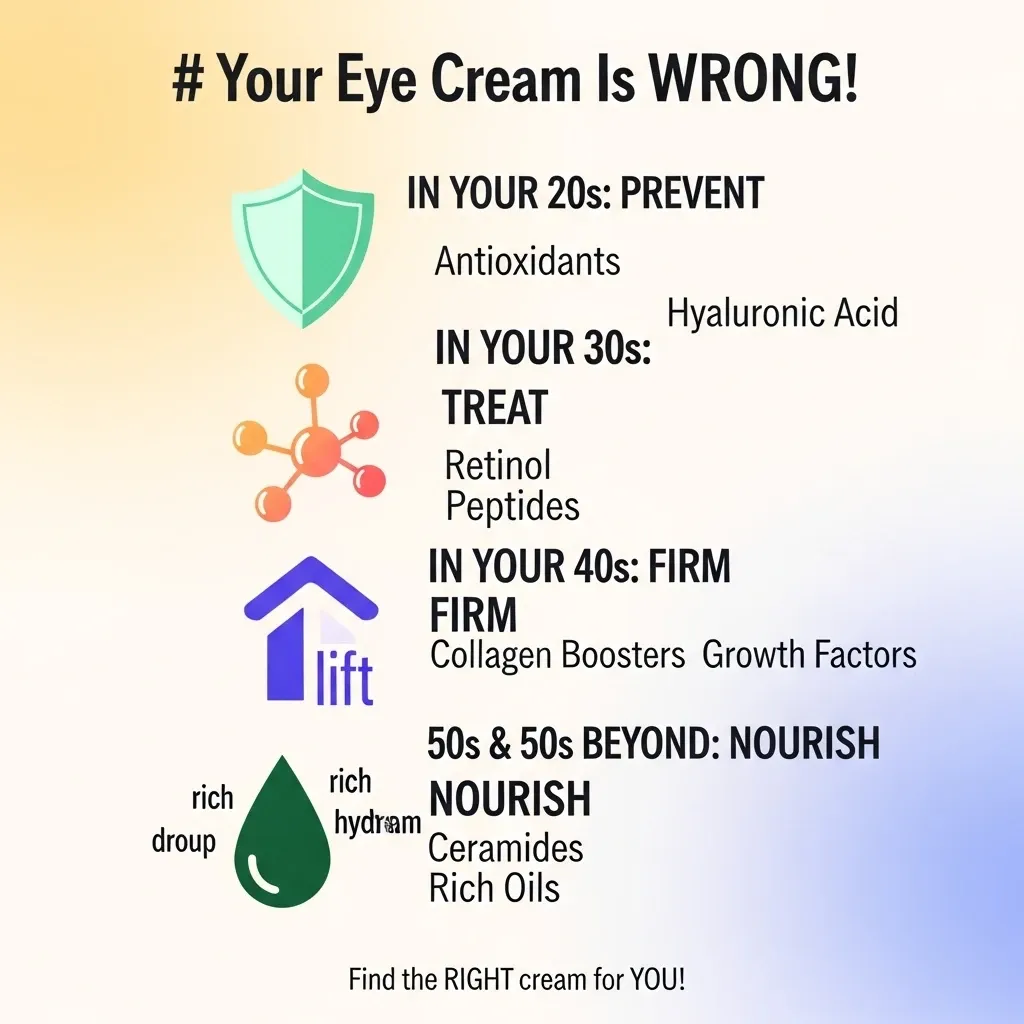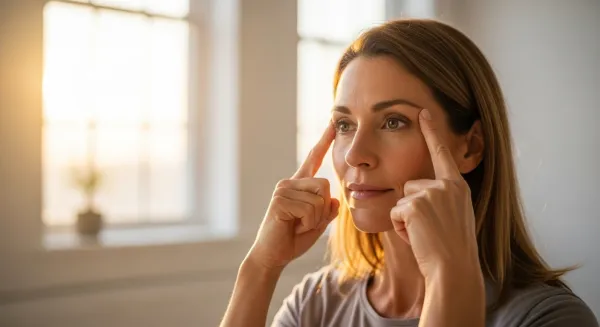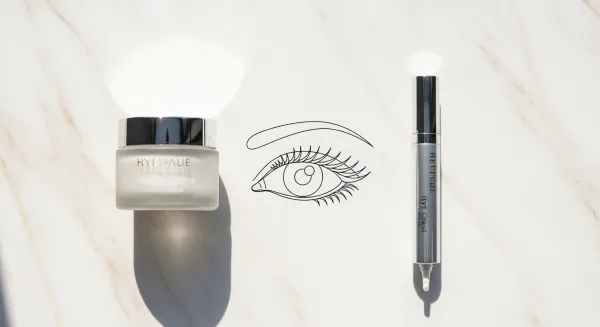The Smart Woman’s Playbook: Eye Cream for Your 20s, 30s, 40s, and Beyond
Eye Cream for Your 20s, 30s, 40s, and Beyond: a simple, decade-by-decade playbook with geo-smart tips, SPF truths, and fuss-free results.

Eye Cream for Your 20s, 30s, 40s, and Beyond isn’t about chasing trends—it’s about choosing the right move for your decade, your climate, and your real life.
Think of this as your no-drama, results-first guide: what to use, when to use it, and how to get the most from every drop without overcomplicating your routine.
👉 List of Premium Eye Creams for You
Affiliate Disclaimer: This post may contain affiliate links, which means I may receive a small commission if you make a purchase through my links, at no extra cost to you. I only recommend products I genuinely believe in and would use myself. Your support helps keep this blog running and allows me to continue creating free content to help you achieve your best skin. Thank you for supporting SkinOptimizer!
At-a-Glance Playbook (Skimmable Summary)
| Decade | Primary Goals | Hero Ingredients | Best Texture | AM / PM Plan |
|---|---|---|---|---|
| 20s | Hydrate, prevent, de-puff | Hyaluronic Acid, Caffeine, Vitamin C, SPF | Gel or light cream | AM: Caffeine + SPF • PM: Hydrator |
| 30s | First fine lines, brightening | Gentle Retinol/Retinal, Peptides, Vitamin C, Niacinamide | Cream-serum | AM: Vitamin C or Peptides • PM: Retinol (2–4x/week) |
| 40s | Firmness, barrier support | Retinol/Retinal, Multi-Peptides, Niacinamide, Ceramides | Cream | AM: Peptides + Vitamin C • PM: Retinoid + Ceramides |
| 50s+ | Deep nourishment, crepey texture | Ceramides/Cholesterol/Fatty Acids, Peptides, Bakuchiol | Rich balm or cream | AM: Barrier cream + SPF • PM: Peptide/Bakuchiol balm |
Why the Eye Area Needs Its Own Plan
The skin under your eyes is thinner, moves constantly (hello, 20,000+ blinks/day), and has fewer oil glands. Translation: it shows dehydration and fatigue faster than the rest of your face.

Yes, some face creams can work around the eyes—but formulas designed for eyes usually avoid heavy fragrance, use gentler actives, and are ophthalmologist-tested.
Curious about when face cream is enough vs when a dedicated eye cream is smarter? Start here: Eye Cream vs. Face Cream Around Eyes.
Quick reality check: Sun is still the #1 accelerator of eye-area aging. A mineral SPF that you’ll reapply is non-negotiable. The Skin Cancer Foundation’s guide to photoaging explains why UV protection matters for wrinkle prevention across every decade.
In Your 20s: Prevent & Protect
Your edge
You’re playing offense. Your goals are hydration, de-puffing, and daily defense.
What to look for
- Hyaluronic Acid for bounce and all-day comfort.
- Caffeine to quickly de-puff and wake up tired eyes—deep dive here: Caffeine Eye Creams—Do They Actually Work?
- Vitamin C for brightening + antioxidant support.
- SPF every morning, including near the orbital bone.
Simple routine
- AM: Tap in a lightweight caffeine gel, then lightly sweep mineral SPF around the orbital bone (don’t hug the lash line).
- PM: Use a hydrating gel-cream and call it a night.
Save vs. Splurge
- Save: A fragrance-free HA + caffeine gel you won’t mind replacing often.
- Splurge: A Vitamin C eye serum with stabilized derivatives for steady brightening.
Lifestyle leverage
- Keep the last salty snack 2–3 hours before bed; sleep on an extra pillow when puffy.
- Keep your gel in the fridge—cold helps with morning swelling.
Further reading: Eye Care Guide: Stop Wasting Money on Products That Don’t Work
In Your 30s: Treat the First Signs
Your edge
Expression lines show up, especially if you squint or smile a lot (which—keep doing both). Now we add gentle actives.

What to look for
- Gentle Retinol/Retinal (start 2x/week and build up): the gold standard for smoothing fine lines. Learn the safe playbook here: Retinol for Eyes—How to Use It Safely
- Peptides to support firmness.
- Vitamin C to keep tone bright and even.
- Niacinamide for barrier support and calm.
Simple routine
- AM: Vitamin C or peptide eye cream, then SPF.
- PM: Retinol eye cream 2–4 nights/week; on off nights, use a peptide + ceramide cream.
Save vs. Splurge
- Save: A peptide-forward cream for daily AM use.
- Splurge: A retinal-based eye cream with soothing buffers (like glycerin + squalane) for steady progress with less irritation.
Smart habits
- Sunglasses with UV protection lower squinting and UV exposure—small habit, big compound effect.
- If concealer creases, try less product after eye cream sets 2–3 minutes.
In Your 40s: Firm & Fortify
Your edge
You’re managing elasticity changes, deeper lines, and drier nights. It’s about potency + buffer.
What to look for
- Retinol or Retinal (consistent PM use).
- Multi-Peptides for firming support.
- Niacinamide to smooth texture and calm.
- Ceramides to rebuild the moisture barrier.
Simple routine
- AM: Peptide cream, optional Vitamin C, SPF.
- PM: Retinoid most nights; seal with a ceramide-rich cream if you run dry.
Save vs. Splurge
- Save: Cream with peptides + niacinamide for day.
- Splurge: Retinal + peptide complex for night that includes barrier lipids to offset dryness.
Pro tip
- If your eyes sting with actives, micro-sandwich: moisturizer → retinoid → a thin sealing layer. Go slow, ramp up.
In Your 50s and Beyond: Nourish & Restore
Your edge
We’re addressing crepey texture, increased dryness, and visible volume changes.
What to look for
- Ceramides / Cholesterol / Fatty Acids (the barrier “trio”) for real comfort.
- Peptides for support.
- Bakuchiol if you prefer a gentler retinol alternative.
- Rich emollients (shea, squalane) for overnight comfort.
Simple routine
- AM: Rich, fragrance-free barrier cream + SPF.
- PM: Peptide or bakuchiol balm; if you tolerate, rotate a retinoid 1–3x/week.
Save vs. Splurge
- Save: A fragrance-free, ceramide-rich cream you can apply generously.
- Splurge: A peptide-dense formula with proven soothing lipids for crepey texture.
Want a broader anti-aging plan beyond eyes? Bookmark Ultimate Guide to Anti-Aging Eye Creams and Power of Retinol for Anti-Aging for deeper dives.
Dark Circles Decoder: Are Yours Brown, Blue, or Hollow?
Not all dark circles are the same. Matching your circle type to the right strategy keeps you from buying the wrong thing—again.
Pigmentary (brown)
- What it looks like: Brown/tan shading that sticks around even when you stretch the skin.
- Better bets: Vitamin C, Niacinamide, gentle brighteners. Consistent SPF is critical—AAD’s skin-care basics has a great primer on daily protection.
- Extra credit: Sunglasses and hats; photo-protection limits future pigment.
Vascular (blue/purple)
- What it looks like: Blueish tone that looks lighter when you gently stretch the skin (you’re seeing vessels under thin skin).
- Better bets: Caffeine (short-term), Retinol (longer-term thickening), cool compresses in the morning.
Structural hollow (tear trough)
- What it looks like: A shadow from a groove under the eye.
- Reality: Creams can soften texture, but shadows from hollowness won’t fully vanish with topicals. Keep expectations aligned and focus on hydration + light-reflecting formulas. (When in doubt, skim 7 Essential Steps to Banish Dark Circles for a complete playbook.)
Geo-Smart Eye Care (Because Climate Matters)
Your eye routine should fit your weather, altitude, and lifestyle—not someone else’s.
- Berlin, London, Amsterdam (cooler, wind + indoor heating): Choose richer creams or balms in winter; look for ceramides. Keep a hydrating mist at your desk.
- LA, Sydney, Dubai (sunny, high UV): Pick fragrance-free, mineral SPF sticks or creams that won’t migrate into eyes. Reapply mid-day. The National Institute on Aging’s overview of skin & aging explains why lifelong UV control pays off.
- High altitude (Denver, Swiss Alps): Less humidity + more UV. Go layered: gel hydrator → cream → SPF → sunglasses with side coverage.
- Humid climates (Singapore, Miami): Lighter gels/serums resist melting under makeup and humidity.
- Allergy-prone seasons (pollen city): Stay fragrance-free; use cold compresses, not rubbing, to avoid broken capillaries.
Application That Actually Works (Zero-Waste Technique)
- Pea-size total for both eyes.
- Tap, don’t rub—use your ring finger and follow the orbital bone.
- Keep off the lash line unless the product says it’s safe for lids.
- Let it set 60–120 seconds before concealer.
- SPF goes last in the morning; reapply with a stick or mineral powder.
Not sure where masks fit? See Do You Put Eye Masks On Before or After Skincare?
Myths We Can Retire
- “One miracle cream works for all ages.” Your 20s and 50s don’t have the same needs. Adjust the playbook, not your standards.
- “If it tingles, it’s working.” The eye area isn’t the place to chase sensations. Comfort = compliance = results.
- “Price guarantees effectiveness.” Formulation and consistency matter more than hype. (If you love luxury textures, enjoy them; you don’t need them to see progress.)
- “Sunscreen irritates my eyes, so I skip it.” Try mineral formulas, keep a tiny buffer from the lash line, and use sunglasses. Your future self will thank you.
The Budget-to-Bougie Matrix (Choose Your Lane)
| Decade | Save (Good) | Splurge (Nice) |
|---|---|---|
| 20s | Fragrance-free HA + caffeine gel | Brightening Vitamin C eye serum |
| 30s | Peptide cream for day | Retinal + barrier-cushioned night cream |
| 40s | Peptide + niacinamide day cream | Retinoid + multi-peptide complex |
| 50s+ | Ceramide-rich comfort cream | Peptide-dense, lipid-rich balm |
Consistency beats complexity. If irritation shows up, scale back, buffer with moisturizer, and reboot slowly. For pregnant or nursing readers, bookmark Pregnancy-Safe Skincare Routine and discuss product choices with your healthcare provider.
Bonus: Makeup That Plays Nice with Eye Cream
- Use less concealer than you think; build in thin layers.
- Choose non-fragrant formulas; set lightly with powder only if creasing.
- If mascara smudges onto your under-eye, try tubing mascara and keep cream slightly farther from the lower lash line in the morning.
FAQs (Real-World, No-Fluff)
For a deeper dive on eye products overall, see Ultimate Guide to Anti-Aging Eye Creams.
1) When should I start using eye cream?
Start in your 20s with hydration + SPF. If you’re in your 30s or beyond, start now with the decade-specific plan above. Preventing dehydration and sun damage early is easier than fixing it later. The Skin Cancer Foundation shows how daily UV adds up.
2) Can I use my face retinol around my eyes?
Sometimes. Buffer with moisturizer and go slowly. Many prefer a retinol designed for eyes because it’s balanced for thin skin. Read the how-to: Retinol for Eyes—Use It Safely.
3) How long until I see results?
- Hydration/de-puffing: minutes to days
- Brightening: 3–6 weeks
- Fine lines from retinoids/peptides: 8–12+ weeks
Consistency wins; more product doesn’t mean faster results.
4) Will an eye cream fix dark circles completely?
It depends on the type. Pigment can brighten with Vitamin C/niacinamide + SPF. Vascular circles respond to caffeine (short-term) and retinoids (long-term). Shadows from hollowness are structural; creams help texture, not volume. Learn the full play: 7 Steps to Banish Dark Circles.
5) Is a luxury eye cream worth it?
It can be—if you love the texture and it keeps you consistent. But excellent drugstore peptide and ceramide formulas exist. If you’re going to splurge, aim for verified actives (retinal/peptides) and a texture you’ll use twice daily. For smart spending, skim Eye Care Guide: Stop Wasting Money.
The Final Takeaway
- 20s: Hydrate, de-puff, SPF.
- 30s: Add gentle retinoids and peptides.
- 40s: Go steady with retinoids, boost peptides, protect your barrier.
- 50s+: Comfort first with ceramides and peptide-rich balms.
Keep it simple, keep it consistent, and match your climate. The best routine is the one you’ll actually do—morning after morning, night after night.
Helpful External Resources
- American Academy of Dermatology—Skin-care basics
- Skin Cancer Foundation—Photoaging & prevention
- National Institute on Aging—Skin & aging overview
Internal Resources to Explore Next
- Eye Cream vs. Face Cream Around Eyes
https://skinoptimizer.com/the-truth-about-eye-cream-vs-face-cream-around-eyes/ - Retinol for Eyes—How to Use It Safely
https://skinoptimizer.com/retinol-for-eyes-how-to-use-it-safely-without-irritation/ - Caffeine Eye Creams—Do They Actually Work?
https://skinoptimizer.com/caffeine-eye-creams-do-they-actually-work-heres-the-playbook/ - 7 Steps to Banish Dark Circles
https://skinoptimizer.com/7-essential-steps-to-permanently-banish-dark-circles-reclaim-bright-eyes/ - Eye Care Guide: Stop Wasting Money
https://skinoptimizer.com/eye-care-guide-stop-wasting-money-on-products-that-dont-work/




